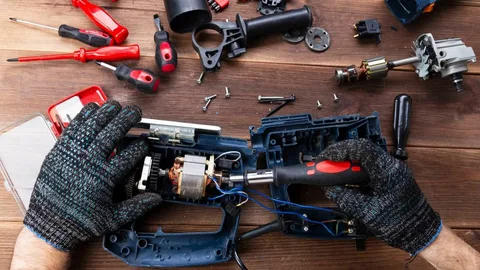Power tool repairs often stall for simple reasons. A drill arrives with no notes. A saw sits while everyone looks for the right switch. Parts are on order, but no one knows when they will land. Customers call for updates, and the bench slows down. None of this is about hard fixes. It is about small habits that waste minutes and pile up into hours. You can speed things up with a clear intake, ready parts, short tests, and quick messages at each step. When tickets, photos, and stock counts live in one place through power tools software, every job moves from drop off to pickup without getting stuck.
In this blog, you will see easy steps to find slow spots and simple habits that make repairs finish faster.
Table of Contents
Find the Real Slow Points
Before you grab a screwdriver, fix the small habits that waste minutes. The steps below show how to keep notes clear, parts ready, and customers informed. Use them together and let your team and tools do their best work.
Run a Quick First Look at the Counter
Slow jobs often start with slow check-ins. When a tool arrives, do the same one-minute test. Try the trigger. Check the cord or battery. Listen for grinding. Note smells or heat. Ask for the problem in the customer’s words and write it down. Take photos from all sides so you can prove the condition later. Save these notes on the ticket and place a small tag on the tool. Now, every tech sees the same facts before anyone opens a case. Easy wins do not sit all day while harder repairs jump the line. A clean start keeps the day moving.
Keep Wear Parts and Common Spares Ready
Repairs stall when the right switch, bearing, or brush is missing. Make small bins for the ten parts you use most. A brush kit should include a pair of brushes, springs, and the correct screws. A switch kit should include the switch, leads, and heat shrink. Face labels forward so the right kit is easy to grab. Set low stock alerts for each fast seller and reorder before the shelf runs dry. Ready kits cut bench time, prevent rush shipping fees, and help new staff learn which parts match which jobs.
Use Short Bench Tests for Repeat Faults
Many power tools share the same weak points. Write a short test card for each family. Rotary hammers need a clutch check. Circular saws need a guard snap test. Drivers need a direction switch test. List the steps in plain words and tape the card near the bench. Run the card once before you quote and once before you close the ticket. These simple tests catch hidden issues early and stop comebacks. They also make handoffs smooth when a job moves to another tech.
Show Live Status and Send Short Updates
Silence creates calls and walk-ins that break focus. Post a status board where staff can see it. Use five steps: Check in, Diagnose, Repair, Test, Ready. Update the step the moment it changes. Send short texts at the same time: We checked your tool. Parts are on the way. Your tool passed tests and is ready for pickup.
Just like Industrial 3D Cameras enhance efficiency in manufacturing by giving teams real-time insights (Industrial 3D Cameras), a clear status board linked with your power tools software keeps customers calm and keeps techs at the bench.
Stop Hunting for Manuals and Past Fixes
Searching for wiring photos, torque specs, or past notes eats time. McKinsey reports that knowledge workers spend nearly 20% of their week just looking for internal information or tracking down colleagues. Save the right documents in one place. Store driver packs, service PDFs, and your own teardown photos in folders that match brands and models. Link them to the ticket so the next tech opens the correct guide in seconds. Fewer searches mean more finished repairs each day.
Create an Express Lane for Quick Wins
Not every job needs the full bench. Set one station for fast work that takes under thirty minutes. Brush swaps. Cord replacements. Dusty guard fixes. Keep the parts for these jobs at that station. Post the time goal on a card and stick to it. The express bench clears small tickets fast, so the main bench can focus on deeper motor and gear repairs. Your daily output rises, and customers love same-day results.
Use One Clean Record for Each Job and Part
Paper notes and numbers in someone’s head slow everyone else down. Keep photos, labels, shelf location, test results, and messages together on a single ticket. When a tech scans a bag, the record opens with everything needed to keep moving. When the front desk checks a ticket, they can see whether parts are on hand or in transit. One screen ends guesswork and stops laps around the shop to ask questions.
In the same way the Future of Smart Home innovations simplify daily life with connected devices Future of Smart Home, a unified ticketing system brings efficiency and clarity to every step of the repair process.
Conclusion
Power tool repairs take longer when small gaps stack up. A quick first look, ready kits, short test cards, live status, one place for manuals, defect quarantine, an express lane, and a simple season plan remove those gaps. Log every note, scan, and message in your power tools software so the shelf and the screen always match. With one system guiding tickets and parts, jobs move from drop off to pickup without stalls. Your team finishes more repairs in the same day, and customers leave with tools that work and timelines that you met.


